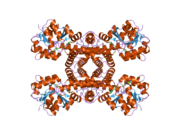From Wikipedia, the free encyclopedia
Protein-coding gene in the species Homo sapiens
In enzymology , a 3-hydroxyisobutyrate dehydrogenase (EC 1.1.1.31 ) also known as β-hydroxyisobutyrate dehydrogenase or 3-hydroxyisobutyrate dehydrogenase, mitochondrial (HIBADH) is an enzyme [5] HIBADH gene .[6]
3-Hydroxyisobutyrate dehydrogenase catalyzes the chemical reaction :
3-hydroxy-2-methylpropanoate + NAD+
⇌
{\displaystyle \rightleftharpoons }
+ Thus, the two substrates of this enzyme are 3-hydroxy-2-methylpropanoate and NAD+ , whereas its 3 products are 2-methyl-3-oxopropanoate , NADH , and H+ .
This enzyme belongs to the family of oxidoreductases , specifically those acting on the CH-OH group of donor with NAD+ or NADP+ as acceptor. The systematic name of this enzyme class is 3-hydroxy-2-methylpropanoate:NAD+ oxidoreductase . This enzyme participates in valine, leucine and isoleucine degradation .
Function [ edit ] 3-hydroxyisobutyrate dehydrogenase is a tetrameric mitochondrial enzyme that catalyzes the NAD+ -dependent, reversible oxidation of 3-hydroxyisobutyrate, an intermediate of valine catabolism, to methylmalonate semialdehyde.[6]
Structural studies [ edit ] As of late 2007, five structures have been solved for this class of enzymes, with PDB accession codes 1WP4 , 2CVZ , 2GF2 , 2H78 , and 2I9P .
References [ edit ] Further reading [ edit ]
Gerhard DS, Wagner L, Feingold EA, et al. (2004). "The status, quality, and expansion of the NIH full-length cDNA project: the Mammalian Gene Collection (MGC)" . Genome Res . 14 (10B): 2121–7. doi :10.1101/gr.2596504 . PMC 528928 PMID 15489334 . Hillier LW, Fulton RS, Fulton LA, et al. (2003). "The DNA sequence of human chromosome 7" . Nature . 424 (6945): 157–64. Bibcode :2003Natur.424..157H . doi :10.1038/nature01782 PMID 12853948 . Scherer SW, Cheung J, MacDonald JR, et al. (2003). "Human chromosome 7: DNA sequence and biology" . Science . 300 (5620): 767–72. Bibcode :2003Sci...300..767S . doi :10.1126/science.1083423 . PMC 2882961 PMID 12690205 . Mammalian Gene Collection Program Team, Strausberg RL, Feingold EA, Grouse LH, et al. (2002). "Generation and initial analysis of more than 15,000 full-length human and mouse cDNA sequences" . Proceedings of the National Academy of Sciences 99 (26): 16899–16903. Bibcode :2002PNAS...9916899M . doi :10.1073/pnas.242603899 PMC 139241 PMID 12477932 . Sanger Centre T, Washington University Genome Sequencing Cente T (1999). "Toward a complete human genome sequence" . Genome Res . 8 (11): 1097–108. doi :10.1101/gr.8.11.1097 PMID 9847074 . Hughes GJ, Frutiger S, Paquet N, et al. (1994). "Human liver protein map: update 1993". Electrophoresis . 14 (11): 1216–22. doi :10.1002/elps.11501401181 . PMID 8313870 . S2CID 33424554 . Rougraff PM, Paxton R, Kuntz MJ, et al. (1988). "Purification and characterization of 3-hydroxyisobutyrate dehydrogenase from rabbit liver" . J. Biol. Chem . 263 (1): 327–31. doi :10.1016/S0021-9258(19)57396-3 PMID 3335502 . Rougraff PM, Zhang B, Kuntz MJ, et al. (1989). "Cloning and sequence analysis of a cDNA for 3-hydroxyisobutyrate dehydrogenase. Evidence for its evolutionary relationship to other pyridine nucleotide-dependent dehydrogenases" . J. Biol. Chem . 264 (10): 5899–903. doi :10.1016/S0021-9258(18)83634-1 PMID 2647728 .
External links [ edit ] Human HIBADH HIBADH UCSC Genome Browser .
PDBe-KB provides an overview of all the structure information available in the PDB for Human 3-hydroxyisobutyrate dehydrogenase, mitochondrial
Activity Regulation Classification Kinetics Types









